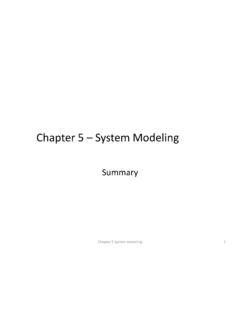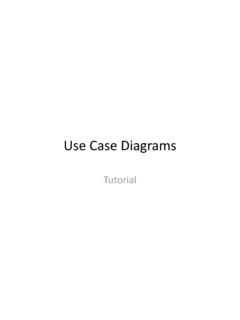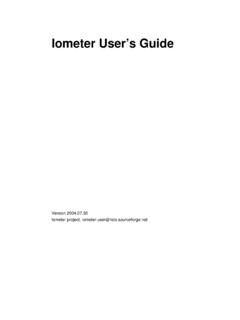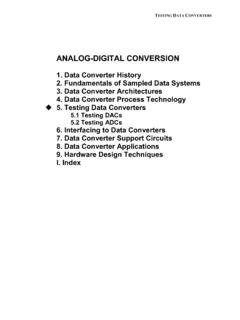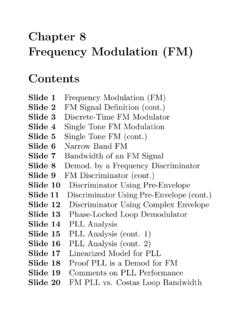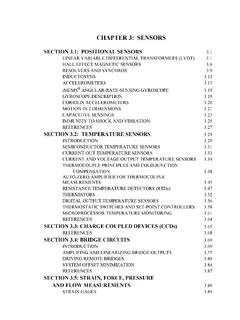Transcription of Chapter 8 – Software Testing - Pace
1 Chapter 8 Software Testing Summary 1 Chapter 8 Software Testing Topics covered Development Testing Test-driven development Release Testing User Testing 2 Chapter 8 Software Testing Program Testing Testing is intended to show that a program does what it is intended to do and to discover program defects before it is put into use. When you test Software , you execute a program using artificial data. You check the results of the test run for errors, anomalies or information about the program s non-functional attributes. Can reveal the presence of errors NOT their absence. Testing is part of a more general verification and validation process, which also includes static validation techniques.
2 Chapter 8 Software Testing 3 Program Testing goals To demonstrate to the developer and the customer that the Software meets its requirements. For custom Software , this means that there should be at least one test for every requirement in the requirements document. For generic Software products, it means that there should be tests for all of the system features, plus combinations of these features, that will be incorporated in the product release. To discover situations in which the behavior of the Software is incorrect, undesirable or does not conform to its specification. Defect Testing is concerned with rooting out undesirable system behavior such as system crashes, unwanted interactions with other systems, incorrect computations and data corruption.
3 4 Chapter 8 Software Testing Validation and defect Testing The first goal leads to validation Testing You expect the system to perform correctly using a given set of test cases that reflect the system s expected use. The second goal leads to defect Testing The test cases are designed to expose defects. The test cases in defect Testing can be deliberately obscure and need not reflect how the system is normally used. 5 Chapter 8 Software Testing Testing process goals Validation Testing To demonstrate to the developer and the system customer that the Software meets its requirements A successful test shows that the system operates as intended. Defect Testing To discover faults or defects in the Software where its behaviour is incorrect or not in conformance with its specification A successful test is a test that makes the system perform incorrectly and so exposes a defect in the system.
4 6 Chapter 8 Software Testing An input - output model of program Testing 7 Chapter 8 Software Testing Verification: "Are we building the product right . The Software should conform to its specification. Validation: "Are we building the right product . The Software should do what the user really requires. Verification vs validation 8 Chapter 8 Software Testing V & V confidence Aim of V & V is to establish confidence that the system is fit for purpose . Depends on system s purpose, user expectations and marketing environment Software purpose The level of confidence depends on how critical the Software is to an organisation. User expectations Users may have low expectations of certain kinds of Software .
5 Marketing environment Getting a product to market early may be more important than finding defects in the program. 9 Chapter 8 Software Testing Software inspections Concerned with analysis of the static system representation to discover problems (static verification) May be supplement by tool-based document and code analysis. Discussed in Chapter 15. Software Testing Concerned with exercising and observing product behaviour (dynamic verification) The system is executed with test data and its operational behaviour is observed. Inspections and Testing 10 Chapter 8 Software Testing Inspections and Testing 11 Chapter 8 Software Testing Software inspections These involve people examining the source representation with the aim of discovering anomalies and defects.
6 Inspections not require execution of a system so may be used before implementation. They may be applied to any representation of the system (requirements, design,configuration data, test data, etc.). They have been shown to be an effective technique for discovering program errors. 12 Chapter 8 Software Testing Advantages of inspections During Testing , errors can mask (hide) other errors. Because inspection is a static process, you don t have to be concerned with interactions between errors. Incomplete versions of a system can be inspected without additional costs. If a program is incomplete, then you need to develop specialized test harnesses to test the parts that are available. As well as searching for program defects, an inspection can also consider broader quality attributes of a program, such as compliance with standards, portability and maintainability.
7 Chapter 8 Software Testing 13 Inspections and Testing Inspections and Testing are complementary and not opposing verification techniques. Both should be used during the V & V process. Inspections can check conformance with a specification but not conformance with the customer s real requirements. Inspections cannot check non-functional characteristics such as performance, usability, etc. 14 Chapter 8 Software Testing A model of the Software Testing process 15 Chapter 8 Software Testing Stages of Testing Development Testing , where the system is tested during development to discover bugs and defects. Release Testing , where a separate Testing team test a complete version of the system before it is released to users.
8 User Testing , where users or potential users of a system test the system in their own environment. Chapter 8 Software Testing 16 Development Testing Development Testing includes all Testing activities that are carried out by the team developing the system. Unit Testing , where individual program units or object classes are tested. Unit Testing should focus on Testing the functionality of objects or methods. Component Testing , where several individual units are integrated to create composite components. Component Testing should focus on Testing component interfaces. System Testing , where some or all of the components in a system are integrated and the system is tested as a whole. System Testing should focus on Testing component interactions.
9 Chapter 8 Software Testing 17 Unit Testing Unit Testing is the process of Testing individual components in isolation. It is a defect Testing process. Units may be: Individual functions or methods within an object Object classes with several attributes and methods Composite components with defined interfaces used to access their functionality. 18 Chapter 8 Software Testing Object class Testing Complete test coverage of a class involves Testing all operations associated with an object Setting and interrogating all object attributes Exercising the object in all possible states. Inheritance makes it more difficult to design object class tests as the information to be tested is not localised.
10 19 Chapter 8 Software Testing The weather station object interface 20 Chapter 8 Software Testing Weather station Testing Need to define test cases for reportWeather, calibrate, test, startup and shutdown. Using a state model, identify sequences of state transitions to be tested and the event sequences to cause these transitions For example: Shutdown -> Running-> Shutdown Configuring-> Running-> Testing -> Transmitting -> Running Running-> Collecting-> Running-> Summarizing -> Transmitting -> Running 21 Chapter 8 Software Testing Automated Testing Whenever possible, unit Testing should be automated so that tests are run and checked without manual intervention. In automated unit Testing , you make use of a test automation framework (such as JUnit) to write and run your program tests.
